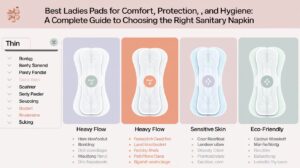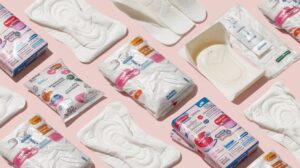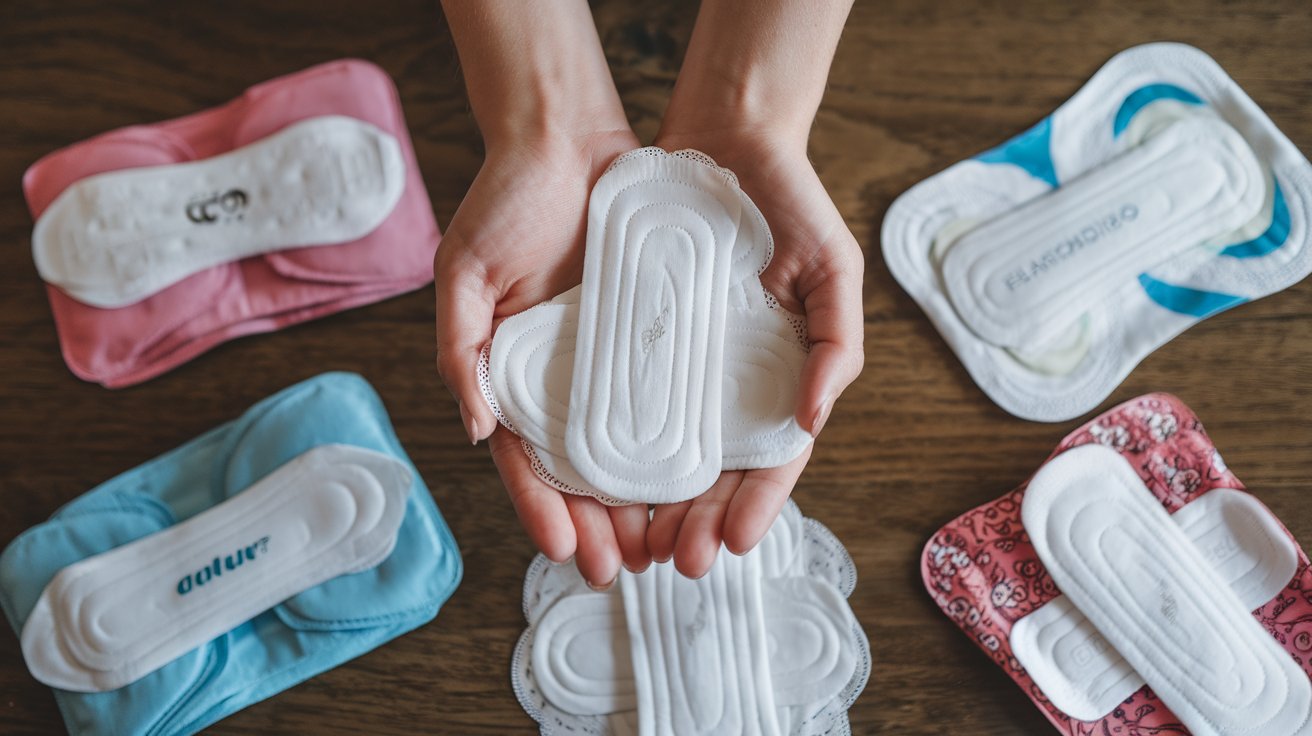Best Ladies Pads for Comfort
Women’s pads are absorbent items designed mainly to help those who are menstruating control their flow. To accommodate diverse demands, they are available in a variety of sizes, shapes, and absorbency levels and are worn within underwear. Because of their accessibility and ease of use, pads are a common and crucial part of managing menstrual hygiene.

Ladies Pads: What Are They?
Women’s pads are absorbent items designed mainly to help those who are menstruating control their flow. To accommodate diverse demands, they are available in a variety of sizes, shapes, and absorbency levels and are worn within underwear. Because of their accessibility and ease of use, pads are a common and crucial part of managing menstrual hygiene.
Ladies Pad Types
Women can select the sanitary pad that best suits their needs by being aware of the various types that are available.
1. Standard Pads
These pads are made for days with mild to medium flow and come in regular sizes. They are a comfortable option for daily wear because they are less large and thick.
2. Pads for Overnight
Compared to standard pads, overnight pads are longer and more absorbent. They provide prolonged coverage and stop leaks even in various sleeping positions because they are made especially for use while you sleep.
4. Exceptionally Thin Pads
Ultra-thin pads offer superior absorbency while remaining discrete and lightweight. For people who value comfort and don’t want the pad to feel heavy, these are perfect.
5. Maxi Pads
Maxi pads are made for days with high flow and are thicker. They are appropriate for the first few days of menstruation because to their increased absorbency levels.
6. Natural Pads
Natural materials, such as organic cotton, are used to make organic pads, which are devoid of artificial chemicals, dyes, and scents. For women with allergies or delicate skin, they are a great option.

How Do Women’s Pads Get Made?
Ladies’ pads are made using many layers, each of which has a distinct function:
Top Layer: Usually composed of cotton or synthetic fabrics that drain away moisture to keep the skin dry, the top layer is soft and kind to the skin.
Absorbent Core: The absorbent materials in this layer, such as super absorbent polymers (SAP) or fluff pulp, keep menstrual fluid contained and stop leaks.
Leak-Proof Barrier: To stop leaks onto clothes, the bottom layer is usually composed of waterproof materials like polyethylene film.
glue: To keep the pad in place while moving, apply a thin coating of glue.
Advantages of Sanitary Pad Use:
1. Simplicity of Use
Because pads are easy to use, people of all ages, even young girls going through their first period, can choose them.
2. Diversification
There is a pad that is appropriate for everyone because to the extensive selection of sizes, thicknesses, and absorbencies.
3. Comfort
With their airy designs, odor-neutralizing technologies, and soft materials, modern pads are made with comfort in mind.
4. Easy Access
Because they are so commonly accessible in pharmacies, supermarkets, and even internet retailers, sanitary pads are simple to buy.
5.hygiene pads
When used and disposed of appropriately, hygiene pads’ disposable nature lowers the danger of infection.

How to Pick the Proper Pad
Choosing the appropriate pad is influenced by many factors:
Flow Intensity:
Select a pad according to how light, medium, or heavy your flow is.
Lifestyle:
For greater security when moving, active ladies can like ultra-thin or winged pads.
Material Preferences:
Choose organic or hypoallergenic pads if your skin is sensitive.
Size: Longer, very absorbent pads are best for strong flow or nighttime usage.
Using a Sanitary Pad:A Guide Sanitary pad use is easy and may be divided into many steps:
Unwrap:
Take off the sticky strip by opening the package.
Position: Adhere the pad’s sticky side to the inside of your panties.
Adjust:
For extra security, fold the pad’s wings over the sides of the underpants if it has them.
Dispose:
Place the used pad in the appropriate container after wrapping it in its wrapper or tissue. Keep it out of the toilet.
Typical Problems and Their Fixes
1. Leakage Cause Using an improperly positioned or inadequately absorbent pad.
Solution: Select the appropriate pad size and periodically verify its placement.
2. Extended pad usage or material sensitivity are the causes of skin irritation.
Solution: Use organic pads and replace them every four to six hours.
3. The source of the odor is accumulated menstrual blood.
Solution: Practice proper hygiene and use pads with odor-lock technology.
Effects on the Environment
Sanitary pads add to environmental waste even if they are handy. The plastic components used to make the majority of disposable pads take years to break down. Here are a few eco-friendly substitutes:
1. Pads that biodegrade
The natural materials used to make these pads decompose more quickly in the environment.
2. Pads That Can Be Used Again
Reusable cotton pads cut down on waste since they can be cleaned and used again and again.
3. Cups for menstruation
Menstrual cups are a zero-waste option for menstrual hygiene, however they are not pads.

Frequently Asked Questions
Q1: How often should I change my pad?
Q2: Can I wear a pad while swimming?
Q3: Are pads safe for teenagers?
Q4: What should I do if I experience skin irritation from pads?
Q5: Can pads cause infections?
Q6: Are organic pads better than regular pads?
Q7: How do I dispose of a sanitary pad properly?

